Item No. 7
Marriage of Heaven and Hell, A Song of Liberty
Copy M, c.1790
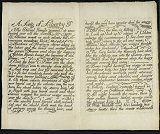
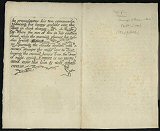
|
Blake developed a method of "Illuminated Printing" for the production of his publications. Using copperplates and relief-etching he developed a method where text and decoration form an integral design and thus as writer, artist and printer he was able to control all aspects of production. Marriage of Heaven and Hell consists of satiric prose sketches directed at the religious visionary and writer Emanuel Swedenborg and the Swedenborgian New Church whose General Conference Blake attended in 1789. Inspired by the French Revolution and the storming of the Bastille, Blake etched a two-leaf political pamphlet poem A Song of Liberty. The three plates of Song normally occur as the last three plates of Marriage of Heaven and Hell. Copy M is unusual in having the Song printed on one sheet forming four pages with the first page left blank. This suggests that perhaps Blake printed it this way to form a separate pamphlet. Copy M represents an important bibliographic discovery about Blake's illuminated printing. Differing considerably from the one other known pamphlet-like copy, Copy M provides information and insight into Blake's work as a printmaker and printer, revealing much about his techniques, ideas and editing practices. |
Items Nos. 8, 9 & 10
Songs of Innocence and of Experience
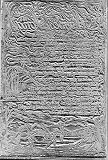 |
Blake invented his method of "Illuminated Printing" in 1788, and Songs of Innocence was among the first works which he produced and published in this way. In the traditional method of etching, the engraving is done by corrosion rather than cutting into the metal with a tool. The surface of a steel or copper plate is covered with varnish or other acid-proof material into which the design is scratched: the exposed surface is then "etched" by the acid. Blake reversed this process, drawing and writing directly on the plate using the acid-proof varnish as his medium and producing the text by mirror or reverse writing so that when printed it would appear as normal text. Assisted by his wife Catherine, plates printed in monochrome were coloured by hand using a transparent watercolour wash. |
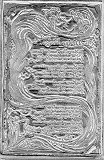 |
The ten plates in the Bentley Collection were printed posthumously from Blake's original copperplates in 1831. Electroplates were made from the copperplates in about 1860 for use in Alexander Gilchrist's Life of William Blake: Pictor Ignotus (London: Macmillan, 1863). The original plates were lost by Frederick Tatham who had taken possession of them after the death of Catherine Blake. Before the Gilchrist electrotypes were destroyed by the publisher in 1961, copies were made for the Fitzwilliam Museum and for Geoffrey Keynes, Blake bibliographer and editor. The examples displayed are from a set made by the Fitzwilliam Museum for G.E. Bentley Jr. in 1964. |
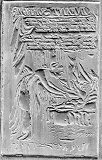 |
Item No. 11
The Riddle Manuscript
?1802
The writing in Blake's hand may be, as G.E.Benley Jr. suggests (Blake Books, 356), "a list of riddles playing with words — 'Love lie Girl' may equal 'Lovely Girl', 'Love Errs' equals 'Lovers', 'Isinglass' equals 'Eyes in Glass', 'an Ell ['L'] taken from London is Undone [ondon]'."
On the verso of the Riddle Manuscript is a proof for William Hayley's Designs to a series of ballads (1802) dated 9 Sept. 1802 in the published version. The leaf was trimmed to the size of the proof and, since the trimming removed the beginnings of lines, it is safe to suggest that the manuscript precedes the proof. |
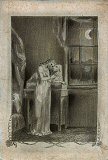 |
 |
Item No. 21
William Blake
Illustrations of the Book of Job invented and engraved by William Blake 1825.
London: published as the act directs March 8, 1825 by William Blake, 1826.
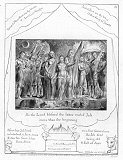
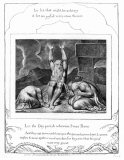
|
In 1805-06 Blake did nineteen watercolours on the subject of Job for Thomas Butts, an early and very important patron and friend. When, years later, John Linnell saw them he immediately conceived of the idea of having Blake paint a duplicate set for him and then of publishing a book of twenty plates designed and engraved by Blake. Since Blake was at this time in straitened circumstances with little prospect of commercial work, Linnell's patronage via the Job project would provide much needed relief. In September of 1821 Butts lent his paintings for Linnell and Blake to trace and then Blake created another watercolour set from the tracings, not only embellishing them with text and illuminated borders but also adding two new designs and a title page. Since the engravings would have to be smaller than the watercolours Blake would have to do another set to work from. Early in 1823 a "Memorandum of Agreement" between Blake and Linnell set out the arrangements for Blake to engrave plates and receive payment. Subscriptions were solicited and even though Blake inscribed each plate with the March 8, 1825 date, it was not until a year later that they were printed. About 300 copies were done, French paper 'proofs', India paper 'proofs', and plain copies on 'drawing paper'. Linnell printed 100 more sets in 1874 but many copies of the 1826 India 'proof' sets remained with the family until sold at auction in 1918.
|
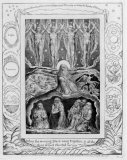
|
|
Item No. 22
William Blake
Blake's Illustrations of Dante. Seven plates designed and engraved by W. Blake, author of "Illustrations of the Book of Job," etc. etc.
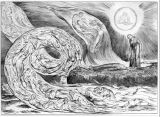
|
Following the Job commission Linnell asked Blake to make a large series of watercolour designs for Dante's Divine Comedy and to engrave them. Blake knew of Dante, had artist friends including Fuseli and Flaxman who had lived in Italy, spoke fluent Italian, and had created paintings and designs from Dante. Blake no doubt felt that he had to know Italian as well before he undertook his designs, so with the help of Henry Cary's translation of The Divine Comedy and his own Latin he quickly taught himself enough Italian to appreciate the substance of Dante's verse. Blake, in failing health did a series of 102 watercolours, some while on his
sick-bed and in fact never finished many of them. He did, however, manage to engrave seven large plates from his designs, and take proofs from them just four months before his death. The engravings were first printed in a small edition (25 copies) in 1838 and in three other equally small editions in 1892, 1955 and 1968.
The Bentley collection set of the 1968 pulls from the original copperplates (then in the Lessing J. Rosenwald collection now in the Library of Congress) was sent by Rosenwald to G.E. Bentley in October 1968. Twenty-five sets were printed. |
Item No. 26
Engraved by William Blake
Lavater
1801.

|
3rd state: there is one known copy of the 1st state and two of the 2nd. |
|


|


![]()